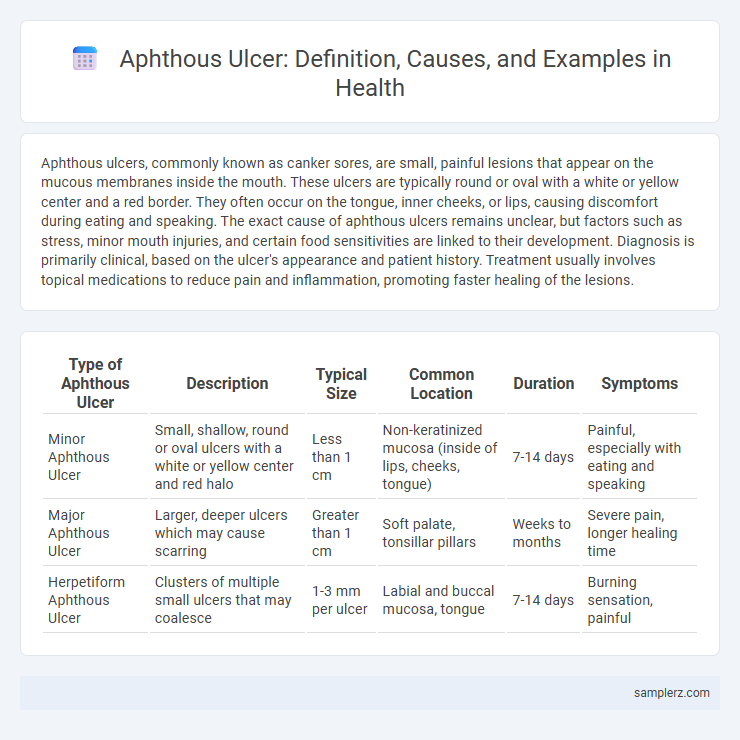Aphthous ulcers, commonly known as canker sores, are small, painful lesions that appear on the mucous membranes inside the mouth. These ulcers are typically round or oval with a white or yellow center and a red border. They often occur on the tongue, inner cheeks, or lips, causing discomfort during eating and speaking. The exact cause of aphthous ulcers remains unclear, but factors such as stress, minor mouth injuries, and certain food sensitivities are linked to their development. Diagnosis is primarily clinical, based on the ulcer's appearance and patient history. Treatment usually involves topical medications to reduce pain and inflammation, promoting faster healing of the lesions.
Table of Comparison
| Type of Aphthous Ulcer | Description | Typical Size | Common Location | Duration | Symptoms |
|---|---|---|---|---|---|
| Minor Aphthous Ulcer | Small, shallow, round or oval ulcers with a white or yellow center and red halo | Less than 1 cm | Non-keratinized mucosa (inside of lips, cheeks, tongue) | 7-14 days | Painful, especially with eating and speaking |
| Major Aphthous Ulcer | Larger, deeper ulcers which may cause scarring | Greater than 1 cm | Soft palate, tonsillar pillars | Weeks to months | Severe pain, longer healing time |
| Herpetiform Aphthous Ulcer | Clusters of multiple small ulcers that may coalesce | 1-3 mm per ulcer | Labial and buccal mucosa, tongue | 7-14 days | Burning sensation, painful |
Understanding Aphthous Ulcers: Definition and Overview
Aphthous ulcers, commonly known as canker sores, are painful, shallow lesions that develop on the mucous membranes inside the mouth, affecting approximately 20% of the general population. These recurrent oral ulcers typically present with a round or oval shape, a white or yellowish center, and a red halo, often causing discomfort during eating, speaking, or oral hygiene. The exact cause remains unclear, but factors such as immune system dysregulation, nutritional deficiencies, and stress have been closely associated with their occurrence.
Common Causes of Aphthous Ulcers
Aphthous ulcers, also known as canker sores, commonly result from factors such as minor oral trauma, stress, and nutritional deficiencies, particularly of vitamin B12, folate, and iron. Other causes include hormonal changes, food sensitivities to items like citrus fruits or gluten, and underlying systemic conditions such as celiac disease or Crohn's disease. Immunologic factors and a family history of aphthous ulcers also contribute to their occurrence and frequency.
Typical Locations of Aphthous Ulcers in the Mouth
Aphthous ulcers, commonly known as canker sores, typically appear on the non-keratinized mucosa of the mouth, including the inner surfaces of the lips, the underside of the tongue, and the soft palate. These ulcers are less frequently found on the hard palate or the gums, areas covered with keratinized tissue. Understanding the typical locations helps in differentiating aphthous ulcers from other oral lesions and aids in accurate diagnosis and treatment.
Key Symptoms of Aphthous Ulcers
Aphthous ulcers typically present as small, round or oval sores with a white or yellowish center and a red halo on the mucous membranes of the mouth. Key symptoms include pain during eating, drinking, or speaking, localized burning or tingling before the ulcers appear, and inflammation around the affected area. Ulcers generally heal within one to two weeks without scarring but can cause significant discomfort.
Types of Aphthous Ulcers: Minor, Major, and Herpetiform
Aphthous ulcers are categorized into three main types: minor, major, and herpetiform, each with distinctive clinical features. Minor aphthous ulcers are the most common, typically small, shallow, and heal within one to two weeks without scarring. Major aphthous ulcers are larger, deeper, may be painful, and often take weeks to heal, sometimes leaving scars, while herpetiform ulcers consist of multiple tiny lesions that cluster and can coalesce, causing significant discomfort.
Risk Factors Contributing to Aphthous Ulcers
Risk factors contributing to aphthous ulcers include nutritional deficiencies such as low levels of vitamin B12, folic acid, and iron, which impair mucosal healing. Stress and hormonal fluctuations significantly increase susceptibility by modulating immune responses that trigger ulcer formation. Genetic predisposition and immune system dysregulation also play critical roles, making individuals more prone to recurrent aphthous stomatitis.
Example Cases: Visual Identification of Aphthous Ulcers
Aphthous ulcers typically present as small, round or oval lesions with a white or yellowish center and a distinct red halo, predominantly found on the non-keratinized mucosa such as the inside of the cheeks, lips, and under the tongue. Visual identification involves recognizing these painful, recurrent ulcers that usually measure less than 1 cm in diameter, commonly classified as minor aphthous stomatitis. Case studies often highlight their appearance in patients experiencing local trauma, stress, or nutritional deficiencies, which aids clinicians in differentiating aphthous ulcers from other oral mucosal conditions.
Diagnosis and Differential Diagnosis of Mouth Ulcers
Aphthous ulcers, commonly presenting as small, round, painful lesions with a yellow or white pseudomembrane and erythematous halo, are typically diagnosed based on clinical examination and patient history. Differential diagnosis includes herpetic stomatitis, characterized by vesicular lesions, and traumatic ulcers, usually linked to mechanical injury or irritation. Definitive diagnosis may require biopsy or laboratory tests to exclude systemic conditions such as Behcet's disease or oral lichen planus.
Effective Treatment Options for Aphthous Ulcers
Aphthous ulcers, commonly known as canker sores, respond effectively to topical corticosteroids such as triamcinolone acetonide and clobetasol propionate, which reduce inflammation and pain. Over-the-counter treatments containing benzocaine or hydrogen peroxide offer symptomatic relief and promote healing by maintaining oral hygiene. In severe cases, systemic therapies including oral corticosteroids or immunomodulatory agents like colchicine may be prescribed to manage recurrent or extensive lesions.
Prevention Tips for Recurrent Aphthous Ulcers
Frequent occurrence of aphthous ulcers, commonly known as canker sores, can be minimized by maintaining good oral hygiene and avoiding foods high in acidity or spice. Using a soft-bristled toothbrush and applying topical protective pastes containing ingredients like benzocaine can reduce irritation. Regular intake of vitamin B12, folate, and iron supplements supports mucosal health and may prevent ulcer recurrence.

example of aphthous in ulcer Infographic
 samplerz.com
samplerz.com